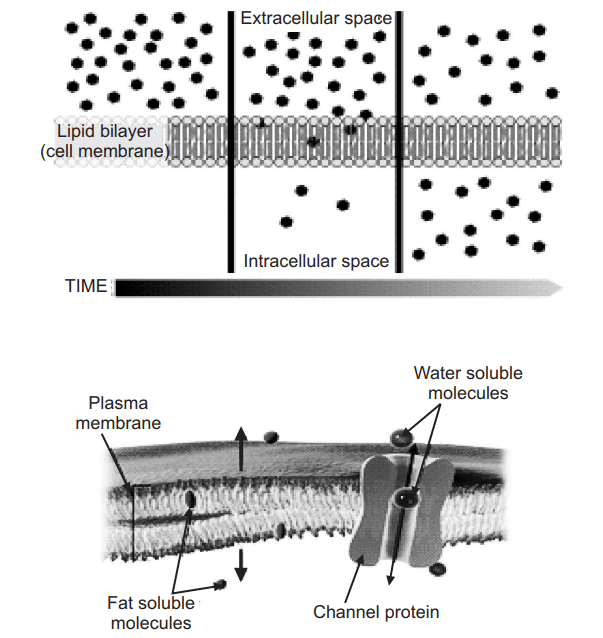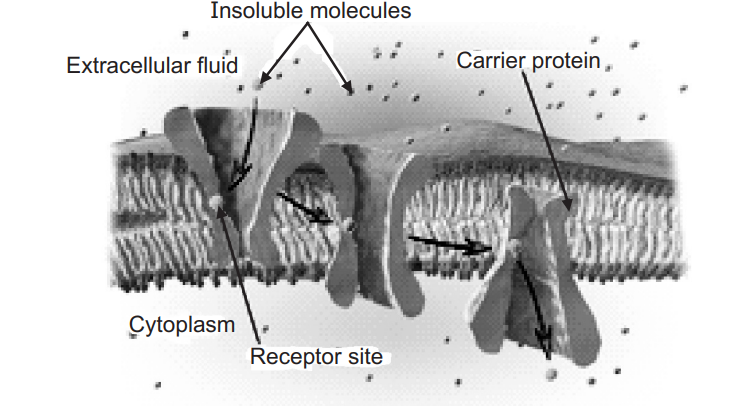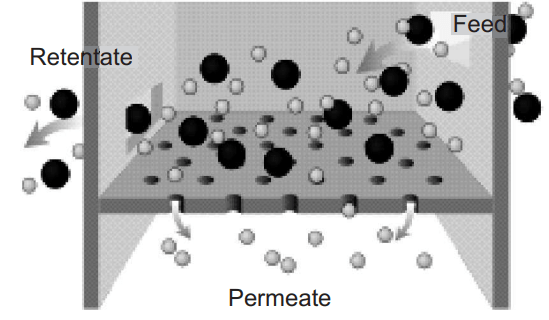Membrane Transport
Membrane transport refers to the collection of mechanisms which regulate the passage of solutes like ions and small molecules through the biological membrane, which are lipid bilayers containing proteins embedded in them. Regulation of passage through the membrane is due to selective membrane permeability – a characteristic of biological membranes which allows them to separate substances of distinct chemical nature. Alternatively, it can be stated that biological membranes are permeable to certain substances but not to others. There are two types of membrane transport in biological tissues.
The movements of most solutes through the membrane are mediated by membrane transport proteins which are specialized to varying degrees in the transport of specific molecules. There are different types of cells; hence specific transport proteins exist for each cell type during a specific physiological state. The differential expression of proteins is regulated through the differential transcription of the genes coding for these proteins. In addition, the production of these proteins can be activated by cellular signaling pathways, at the biochemical level, or even by cytoplasmic vesicles.
Membrane Transport Types
There are two types of membrane transport in biological tissues viz Passive transport and Active transport.
- Passive transport
- Active transport
Passive transport
It is a movement of ions and other atomic/molecular substances across a cell membrane without the input of metabolic energy. The concentration gradient of the transported substances acts as a source of energy. The rate of passive transport depends on the permeability of the cell membrane, which in turn, depends on the organization and characteristics of the membrane lipids. There are four mechanisms for passive transport: diffusion facilitated diffusion, filtration, and osmosis.
(i) Diffusion: Diffusion is the net movement of material from an area of high concentration to an area with lower concentration. The difference in concentration between two sides of the membrane is called a concentration gradient. Diffusion continues only till the gradient is eliminated. (Fig. 1.1).

(ii) Facilitated diffusion: Facilitated diffusion is also called carrier-mediated osmosis. It is the movement of molecules across the cell membrane via special transport proteins embedded within the cell membrane (Fig. 1.2). It is a passive process. Carrier proteins allow diffusion of molecules across the cell membrane by undergoing conformational alterations to allow molecules to pass across the membrane. It may be achieved as a consequence of charged gradients in addition to concentration gradients.

(iii) Filtration: Filtration is the movement of water and solute molecules across the cell membrane due to hydrostatic pressure generated by the cardiovascular system. Depending on the size of the membrane pores, only solutes of a certain size may pass through it (Fig. 1.3). An example of water along with ions like sodium, and potassium passing through the membrane pores of Bowman’s capsule, while retaining albumin in the blood can be cited.

(iv) Osmosis: Osmosis is the movement of water molecules across a selectively permeable membrane. It can be easily explained by the behavior of red blood cells in a solution of sodium chloride. Depending on the concentration of sodium chloride, the solution can be labeled as one of the three types: isotonic, hypertonic, or hypotonic. Three words indicate that the pressure exerted by sodium chloride is the same, higher, or lower than that of pressure exerted by the solutes in red blood cells (RBCs). RBCs do not change their shape in an isotonic solution. They shrink in a hypertonic solution and swell in a hypotonic solution. It is due to the movement of water across the cell membrane.
Active transport
Active transport is the movement of molecules across a cell membrane from a region of lower concentration to a region of higher concentration- in the direction against the concentration gradient. This is due to the expenditure of metabolic energy. Unlike passive transport, which uses the kinetic energy and natural property of molecules moving down a gradient, active transport uses metabolic energy to move them against a concentration gradient, polar repulsion, or other resistance. Active transport is associated with accumulating high concentrations of molecules that the cell needs: e.g. sodium/ potassium/calcium ions, glucose, amino acids, etc. if the process uses energy in the form of ATP, it is termed primary active transport. Secondary active transport involves the use of an electrochemical gradient.
The best example of primary active transport is the sodium-potassium pump. The pump maintains the membrane potential by moving three sodium ions out of the cell for every two potassium ions moved into the cell by hydrolysis of one ATP molecule. The pump is an enzyme dependent on the activity of sodium and potassium ions with the ability to hydrolyze ATP. It is located on the membrane of the cell. An example of secondary active transport is that of the enzyme ATP synthase. The energy derived from the pumping of a proton across a cell membrane is frequently used as the energy source in secondary active transport. In humans, sodium is commonly a co-transported ion across the plasma membrane, whose electrochemical gradient is then used to power the active transport of a second ion or a molecule against its gradient.
Make sure you also check our other amazing Article on: Urinary Tract Infection
